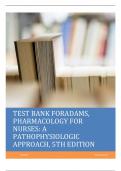Exam (elaborations)
Test Bank For Pharmacology for Nurses , A Pathophysiologic Approach 5th Edition by Michael
- Course
- Institution
- Book
Chapter 1 of "Adams, Pharmacology for Nurses: A Pathophysiologic Approach, 5/E" provides a comprehensive overview of the history and fundamental concepts of pharmacology. It covers the initial drugs used, the role of early researchers, and the development of modern pharmacology. The chapter emphasi...
[Show more]



